Hokuto Munakata
Language-Guided Contrastive Audio-Visual Masked Autoencoder with Automatically Generated Audio-Visual-Text Triplets from Videos
Jul 16, 2025Abstract:In this paper, we propose Language-Guided Contrastive Audio-Visual Masked Autoencoders (LG-CAV-MAE) to improve audio-visual representation learning. LG-CAV-MAE integrates a pretrained text encoder into contrastive audio-visual masked autoencoders, enabling the model to learn across audio, visual and text modalities. To train LG-CAV-MAE, we introduce an automatic method to generate audio-visual-text triplets from unlabeled videos. We first generate frame-level captions using an image captioning model and then apply CLAP-based filtering to ensure strong alignment between audio and captions. This approach yields high-quality audio-visual-text triplets without requiring manual annotations. We evaluate LG-CAV-MAE on audio-visual retrieval tasks, as well as an audio-visual classification task. Our method significantly outperforms existing approaches, achieving up to a 5.6% improvement in recall@10 for retrieval tasks and a 3.2% improvement for the classification task.
DETECLAP: Enhancing Audio-Visual Representation Learning with Object Information
Sep 18, 2024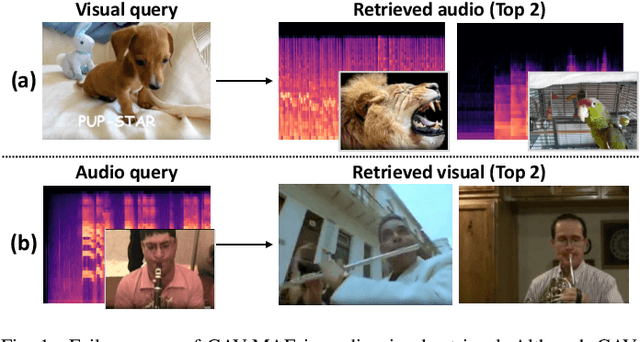
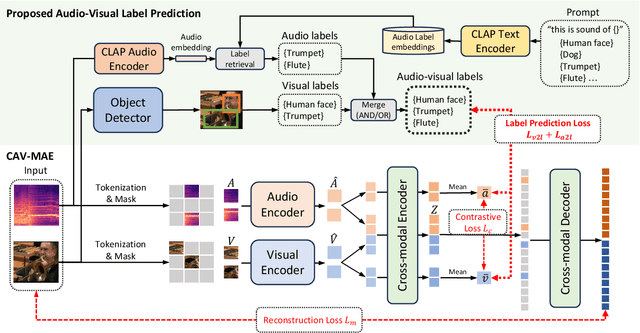
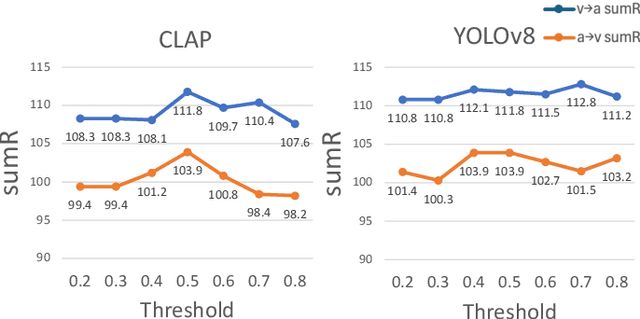
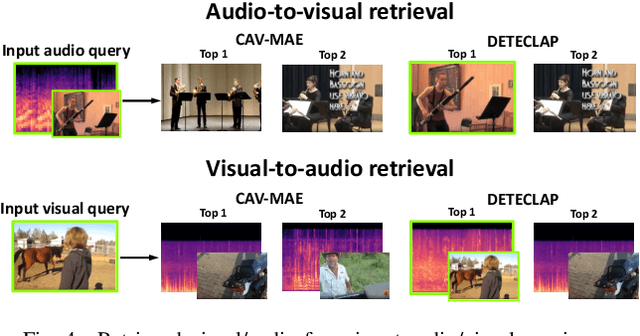
Abstract:Current audio-visual representation learning can capture rough object categories (e.g., ``animals'' and ``instruments''), but it lacks the ability to recognize fine-grained details, such as specific categories like ``dogs'' and ``flutes'' within animals and instruments. To address this issue, we introduce DETECLAP, a method to enhance audio-visual representation learning with object information. Our key idea is to introduce an audio-visual label prediction loss to the existing Contrastive Audio-Visual Masked AutoEncoder to enhance its object awareness. To avoid costly manual annotations, we prepare object labels from both audio and visual inputs using state-of-the-art language-audio models and object detectors. We evaluate the method of audio-visual retrieval and classification using the VGGSound and AudioSet20K datasets. Our method achieves improvements in recall@10 of +1.5% and +1.2% for audio-to-visual and visual-to-audio retrieval, respectively, and an improvement in accuracy of +0.6% for audio-visual classification.
Lighthouse: A User-Friendly Library for Reproducible Video Moment Retrieval and Highlight Detection
Aug 06, 2024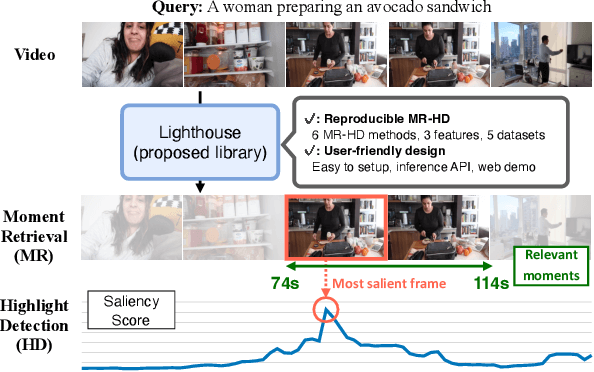


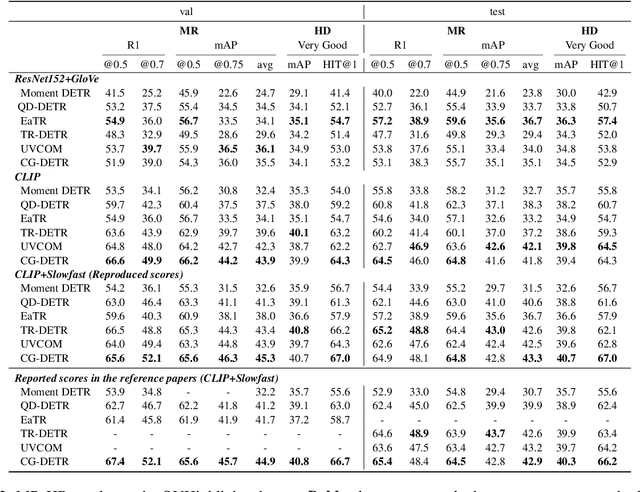
Abstract:We propose Lighthouse, a user-friendly library for reproducible video moment retrieval and highlight detection (MR-HD). Although researchers proposed various MR-HD approaches, the research community holds two main issues. The first is a lack of comprehensive and reproducible experiments across various methods, datasets, and video-text features. This is because no unified training and evaluation codebase covers multiple settings. The second is user-unfriendly design. Because previous works use different libraries, researchers set up individual environments. In addition, most works release only the training codes, requiring users to implement the whole inference process of MR-HD. Lighthouse addresses these issues by implementing a unified reproducible codebase that includes six models, three features, and five datasets. In addition, it provides an inference API and web demo to make these methods easily accessible for researchers and developers. Our experiments demonstrate that Lighthouse generally reproduces the reported scores in the reference papers. The code is available at https://github.com/line/lighthouse.
Song Data Cleansing for End-to-End Neural Singer Diarization Using Neural Analysis and Synthesis Framework
Jun 24, 2024



Abstract:We propose a data cleansing method that utilizes a neural analysis and synthesis (NANSY++) framework to train an end-to-end neural diarization model (EEND) for singer diarization. Our proposed model converts song data with choral singing which is commonly contained in popular music and unsuitable for generating a simulated dataset to the solo singing data. This cleansing is based on NANSY++, which is a framework trained to reconstruct an input non-overlapped audio signal. We exploit the pre-trained NANSY++ to convert choral singing into clean, non-overlapped audio. This cleansing process mitigates the mislabeling of choral singing to solo singing and helps the effective training of EEND models even when the majority of available song data contains choral singing sections. We experimentally evaluated the EEND model trained with a dataset using our proposed method using annotated popular duet songs. As a result, our proposed method improved 14.8 points in diarization error rate.
 Add to Chrome
Add to Chrome Add to Firefox
Add to Firefox Add to Edge
Add to Edge